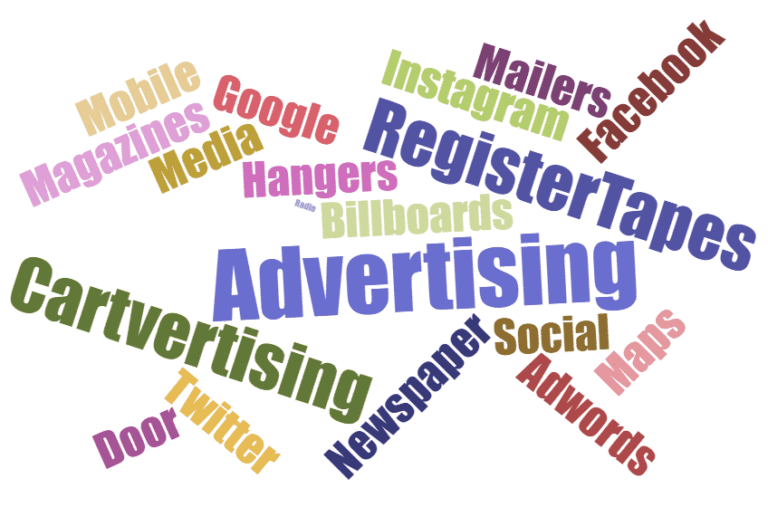Cartvertising and Receipt Coupons: Two Ways to Advertise in Your Grocery Store
Marketing and advertising a small business is an essential component of attracting new customers and retaining existing ones. However, with so many mediums and media available, it can be tough to discern which methods drive results and are the most bang for your buck. On one hand, traditional advertising is expensive. On the other, digital advertising can be tough to maintain and unpredictable.
Grocery store advertising is a tried-and-true technique that enables owners to reap the benefits of large-scale, expensive national campaigns at a fraction of the price. Between coupon advertising on receipts and grocery cart advertising business owners can rely on proven methods to drive results.
To help you determine the best way to advertise your business in a grocery store, let’s explore the differences between cartvertising (grocery cart ads) and coupons.
Shopping Cart Advertising
Advertising on grocery store carts enables companies to produce beautiful, full-color ads that make an impression on a targeted audience. For brands looking to increase long-term brand awareness and recognition, the benefits of cartvertising may be for you.
Customization
Think of cart advertisements as miniature billboards. Grocery cart ads are full-color and custom-designed to showcase your business. Because of their size, these beautiful ads can convey more information to increase brand awareness, recognition, and reach.
Not only does shopping cart advertising significant design choices, it also provides a potential for personalization of the message itself. Business owners can tailor marketing messaging based on age, gender, average household income, and other demographic factors to ensure that ads are reaching a relevant audience.
And when advertising with supermarkets, businesses pay for the ads running in a particular store. This means that business owners know exactly where they’re making an investment. Plus, because both the primary and secondary shopper in a household will shop for groceries, business owners can rest easy, knowing that ads are being seen by decision-makers.
Exposure
Shopping Cart Advertising places ads directly where customers look while grocery shopping: their shopping carts. Unlike many advertising methods—including everything from email to snail mail—there are fewer variables and uncertainties as to whether your ads are being seen by consumers. The average shopper spends 43 minutes in the grocery store per trip. What’s more, they visit local stores an average of 1.7 times per week.
This means that your ad is literally inches from your consumers’ eyes more than an hour per week and more than 80 times per year. Unlike direct mail and receipt coupons, which consumers may inadvertently ignore, each trip to the grocery store is an opportunity for your brand to be seen by your consumers.
Receipt Coupons
Looking for a short-term solution to drive traffic? Grocery store receipt coupons not only drive specific customers to small businesses in their area, they also tout a surprisingly strong return on investment (ROI).
Personalization
We’ve already reviewed how cartvertising enables customization. Receipt advertising showcases businesses on receipt tapes in local grocery stores and is handed to every customer during checkout. And it can be equally personalized. Coupon advertising enables business owners to boost sales by targeting specific customers, products, or events. When you deliver personalized promotions, consumers are more likely to visit your business, spend money, and boost your profits.
The typical grocery store customer lives within three miles of their preferred grocery store. Receipt coupon campaigns enable business owners to reach hyper-specific customers. Location targeting, combined with demographic information, allows businesses to distribute messaging to exactly the right audience. At an average grocery store, that means 20,000 potential or existing customers will come in contact with your offer every week.
Coupons not only reach a specific demographic, they influence how consumers act and how much money they spend. In fact, 90 percent of adult consumers said coupons impact the amount they spend and the items they purchase. They also help take consumers from your competition. 78 percent of consumers said a coupon influenced them to buy a new brand. And 80 percent of shoppers said they would switch stores or brands when offered a compelling promotion.
Tracking ROI
Tracking the ROI of your advertising and marketing efforts can be difficult. Because so many small businesses are on shoestring budgets to begin with, it’s important for your investments to be smart. Advertising on shopping carts comes with the huge benefit of exposure, it’s tracking a sale back to a specific ad at a specific store can be tricky. This is the opposite for coupon advertising.
One of the best features of coupon advertising is how simple it is to track performance: A customer exchanges a coupon, you gain a sale. This boosts the value of coupon advertising as business owners know exactly how a particular offer, design, or location is performing.
Perceived vs. Face Value of Offers
Ultimately, coupons that display actual dollar amounts get the most perceived value from consumers. An offer in which customers pay $15 for a $30 or more purchase does better than simply offering 20 percent off. Why? This type of coupon provides them with the impression that they are receiving 50 percent off a purchase. However, let’s suppose your average sales ticket is more than $45. This means that the actual discount will be around 30 percent while the perceived value is still 50 percent off.
Which is better for you? Cartvertising or coupons?




